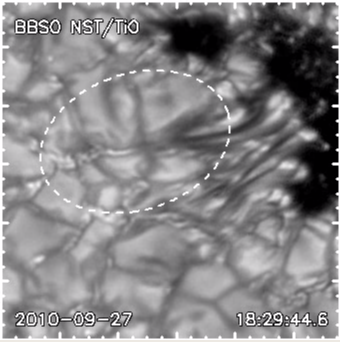 TiO movie showing emergence of a new magnetic flux in the photosphere (encircled) of
an active region NOAA 11109. Here a small sunspot is partially surrounded by a
penumbra, and an elongated granule-like feature forms at the tip of the penumbral filament. The field of view is about 11.6" by 11.6". ) (Posted: June 7, 2011)
TiO movie showing emergence of a new magnetic flux in the photosphere (encircled) of
an active region NOAA 11109. Here a small sunspot is partially surrounded by a
penumbra, and an elongated granule-like feature forms at the tip of the penumbral filament. The field of view is about 11.6" by 11.6". ) (Posted: June 7, 2011)
|
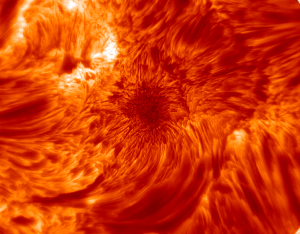 This image was taken on 2014 October 02 using the BBSO 1.6 meter New Solar Telescope (NST). The image shows the chromosphere over a relatively small sunspot in NOAA 12177 in the H-alpha line center. The data were taken with the NST Visible Imaging Spectrometer (VIS). VIS uses a Fabry-Pérot etalon to very quickly scan over a range of up to +/-1.0 Å at a bandpass of 0.07 Å. The high speed 2048x2048 camera array covers a 70 arcsecond field of view. This particular image is the product of 25 frames selected out of a total of 50 taken in a quick burst, each with an exposure of 20 ms. The frames were processed using speckle reconstruction to create the final science image. A colorized and contrast adjusted version of the image by Alan Friedman will be featured as the Astronomy Picture of the Day (APOD) on 2015 February 17 .
This image was taken on 2014 October 02 using the BBSO 1.6 meter New Solar Telescope (NST). The image shows the chromosphere over a relatively small sunspot in NOAA 12177 in the H-alpha line center. The data were taken with the NST Visible Imaging Spectrometer (VIS). VIS uses a Fabry-Pérot etalon to very quickly scan over a range of up to +/-1.0 Å at a bandpass of 0.07 Å. The high speed 2048x2048 camera array covers a 70 arcsecond field of view. This particular image is the product of 25 frames selected out of a total of 50 taken in a quick burst, each with an exposure of 20 ms. The frames were processed using speckle reconstruction to create the final science image. A colorized and contrast adjusted version of the image by Alan Friedman will be featured as the Astronomy Picture of the Day (APOD) on 2015 February 17 .
(Posted: Feb 10, 2015)
|
|
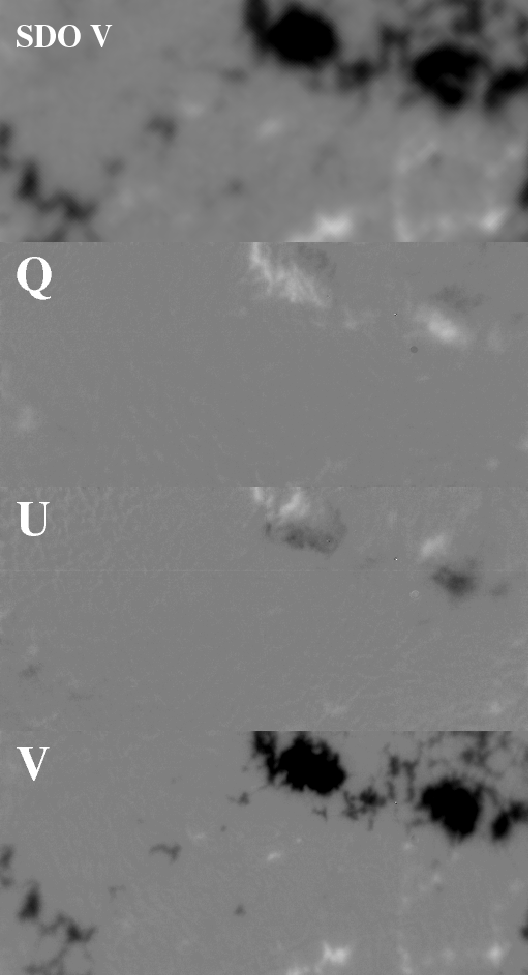 Top panel: Stokes V image of SDO/HMI; Three bottom panels:
Vector magnetogram of a cluster of pores near AR 11121 at 231E
391S, taken on Nov. 09, 2010. Q, U, and V denote calibrated
NST/IRIM Stokes Q, U and V images. Dual-beam technology was
employed to minimize seeing-induced noise. The center of the
strongest pore has a longitudinal magnetic field strength of
about 1 kG. The field of view of IRIM is about 50"x25".
(Posted: June 6, 2011)
Top panel: Stokes V image of SDO/HMI; Three bottom panels:
Vector magnetogram of a cluster of pores near AR 11121 at 231E
391S, taken on Nov. 09, 2010. Q, U, and V denote calibrated
NST/IRIM Stokes Q, U and V images. Dual-beam technology was
employed to minimize seeing-induced noise. The center of the
strongest pore has a longitudinal magnetic field strength of
about 1 kG. The field of view of IRIM is about 50"x25".
(Posted: June 6, 2011)
|
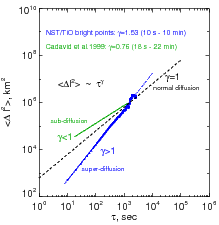 By tracking NST TiO bright points, we can measure their mobility over different
time intervals. The result is a so called displacement spectrum, which obeys the
power law. We have found that the corresponding power index sigificantly exceeds
unity (1.53 ± 0.005). This is an indication of super-diffusivity of the
magnetic fields in the solar photosphere. In this regime, the diffusion
coefficient is directly proportional to the spatial scales.
This is the first time that superdiffusivity was detected in the photosphere.
This new finding may lead us to fundamentally different
physics of magnetic flux dispersal and, ultimately, our understanding of both
global and local (turbulent) solar dynamos will be greatly improved.
(Posted: June 7, 2011)
By tracking NST TiO bright points, we can measure their mobility over different
time intervals. The result is a so called displacement spectrum, which obeys the
power law. We have found that the corresponding power index sigificantly exceeds
unity (1.53 ± 0.005). This is an indication of super-diffusivity of the
magnetic fields in the solar photosphere. In this regime, the diffusion
coefficient is directly proportional to the spatial scales.
This is the first time that superdiffusivity was detected in the photosphere.
This new finding may lead us to fundamentally different
physics of magnetic flux dispersal and, ultimately, our understanding of both
global and local (turbulent) solar dynamos will be greatly improved.
(Posted: June 7, 2011) |
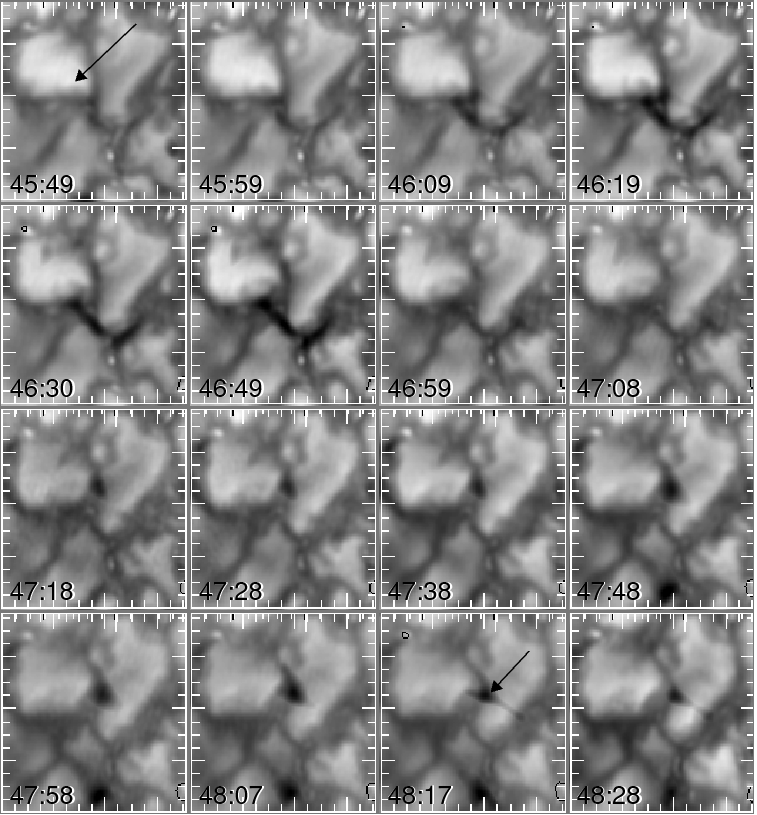 We observe that intergranular jets, originating in the intergranular
space surrounding individual granules, tend to be associated with granular
fragmentation, in particular, with the formation and evolution of a bright
granular lane (BGL) within individual granules.
This is a sequence of composite images made by combining TiO granulation data
and dark Halpha-0.1nm absorption features. The arrow in the 45:49 frame points
toward the BGL. The onset of chromospheric jet-like activity begins
shortly after a bright grain develops (frames 46:09-46:59). The arrow in the
48:17 frame indicates an inverted "Y" jet occurring at approximately the same
position as the BGL. The time stamp in each frame shows the minute and
second of image acquisition starting from 17:00:00UT. Short tick marks separate
0.25Mm spatial intervals.
We observe that intergranular jets, originating in the intergranular
space surrounding individual granules, tend to be associated with granular
fragmentation, in particular, with the formation and evolution of a bright
granular lane (BGL) within individual granules.
This is a sequence of composite images made by combining TiO granulation data
and dark Halpha-0.1nm absorption features. The arrow in the 45:49 frame points
toward the BGL. The onset of chromospheric jet-like activity begins
shortly after a bright grain develops (frames 46:09-46:59). The arrow in the
48:17 frame indicates an inverted "Y" jet occurring at approximately the same
position as the BGL. The time stamp in each frame shows the minute and
second of image acquisition starting from 17:00:00UT. Short tick marks separate
0.25Mm spatial intervals.
|
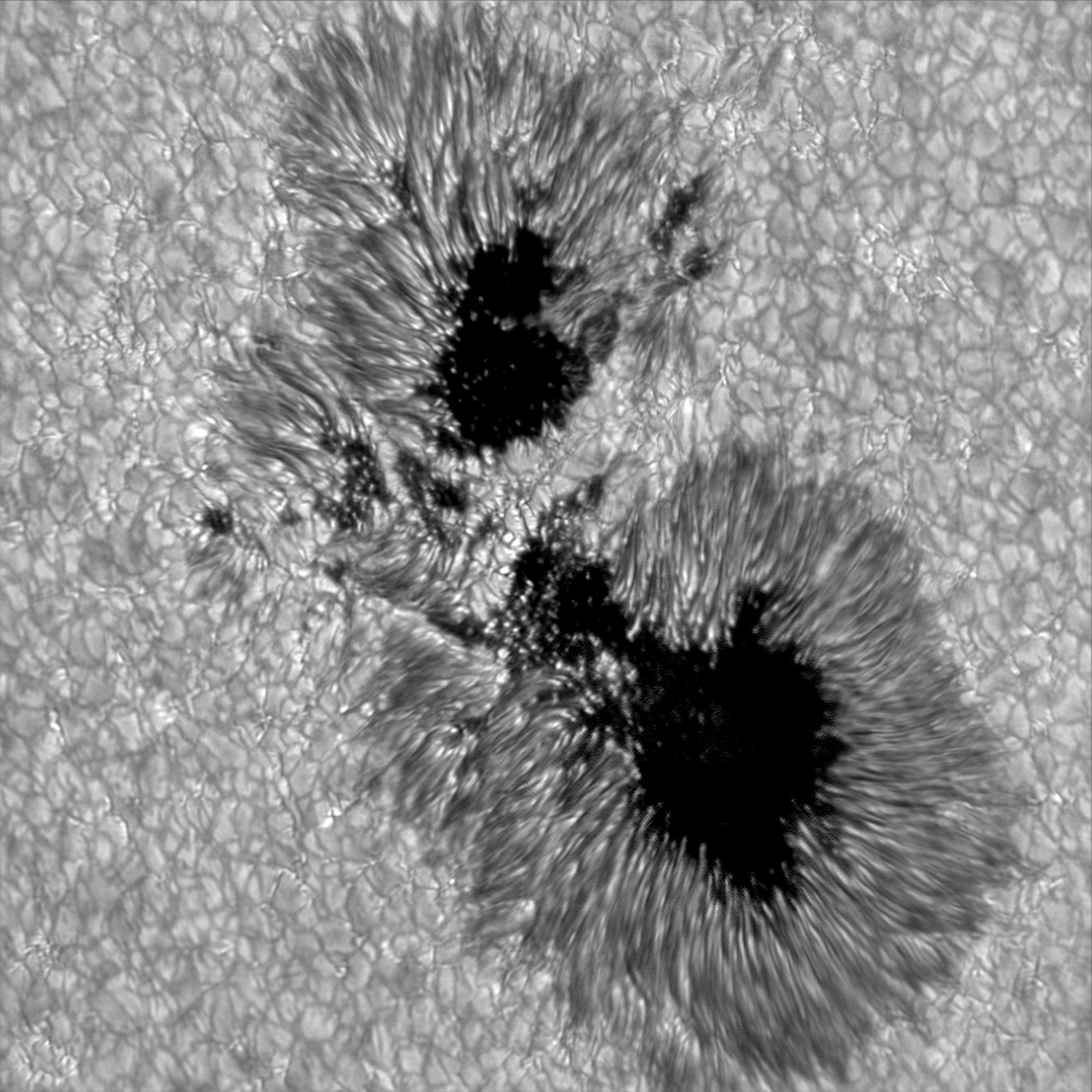 AR NOAA 11108 observed with the NST/TiO imager on Sept 20, 2011.
This image was published by
Ciel et Espace. (Posted: June 6, 2011)
AR NOAA 11108 observed with the NST/TiO imager on Sept 20, 2011.
This image was published by
Ciel et Espace. (Posted: June 6, 2011)
|
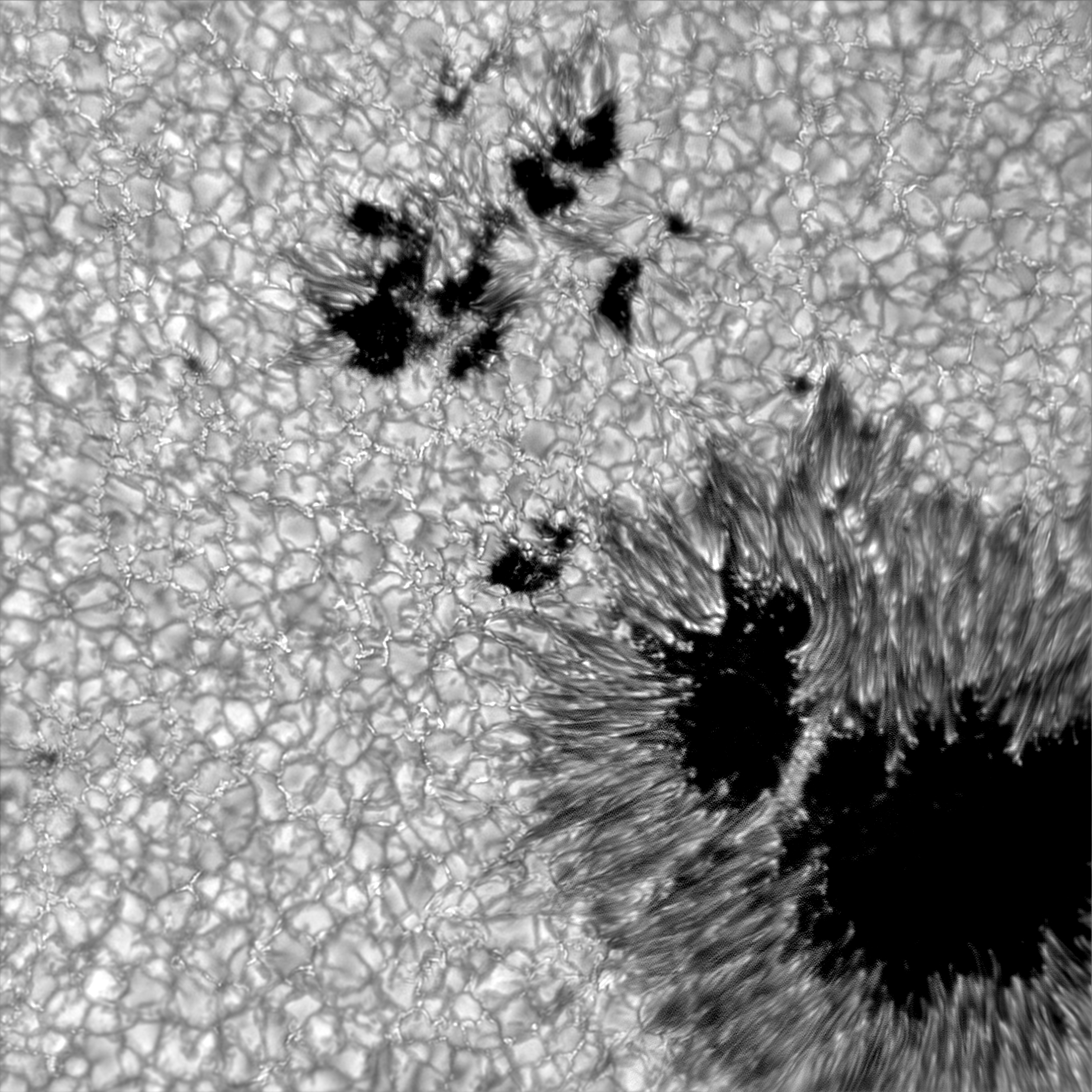 AR NOAA 11109 observed with the NST/TiO imager on Sept 27, 2011.
This image was published by
Ciel et Espace. (Posted: June 6, 2011)
AR NOAA 11109 observed with the NST/TiO imager on Sept 27, 2011.
This image was published by
Ciel et Espace. (Posted: June 6, 2011)
|
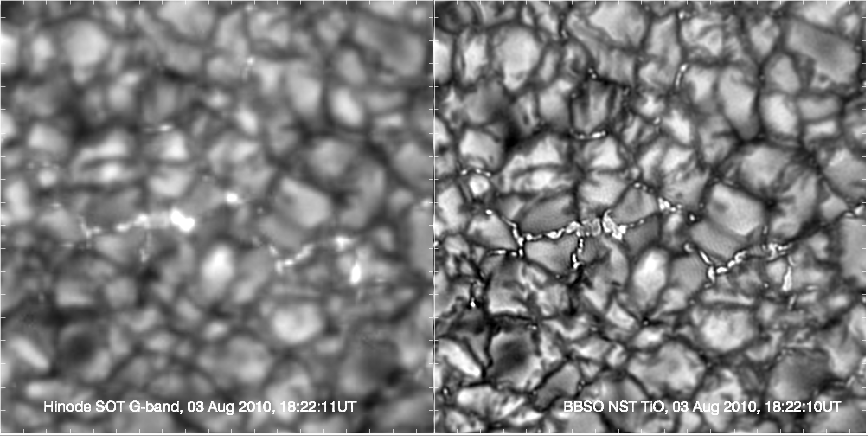 A 19" by 19" Hinode/SOT g-band (left) and NST TiO (right) image of the same area
of the Sun acquired on Aug 3, 2010 . The NST image clearly displays several
tight clusters of resolved BPs near the center of the FOV, which are seen in
the Hinode image as single bright patches. Meanwhile, there are indications
that such tight clusters of various size are located at roots of chromospheric
up flow events. The spatial and temporal resolution of the data allows us to
track these individual BPs during their lifetime.
(Posted: June 6, 2011)
A 19" by 19" Hinode/SOT g-band (left) and NST TiO (right) image of the same area
of the Sun acquired on Aug 3, 2010 . The NST image clearly displays several
tight clusters of resolved BPs near the center of the FOV, which are seen in
the Hinode image as single bright patches. Meanwhile, there are indications
that such tight clusters of various size are located at roots of chromospheric
up flow events. The spatial and temporal resolution of the data allows us to
track these individual BPs during their lifetime.
(Posted: June 6, 2011) |
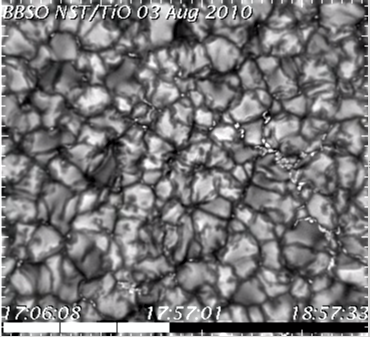 TiO granulation recorded on 03 August 2010. The field of view is about 28"x25".
One tick mark measures 10 pixels long with one pixel = 0.075". ("-means 'arcsecond'
which corresponds to 725km on the Sun)
TiO granulation recorded on 03 August 2010. The field of view is about 28"x25".
One tick mark measures 10 pixels long with one pixel = 0.075". ("-means 'arcsecond'
which corresponds to 725km on the Sun)
 (Posted: Sept: 7, 2010) (Posted: Sept: 7, 2010)
|
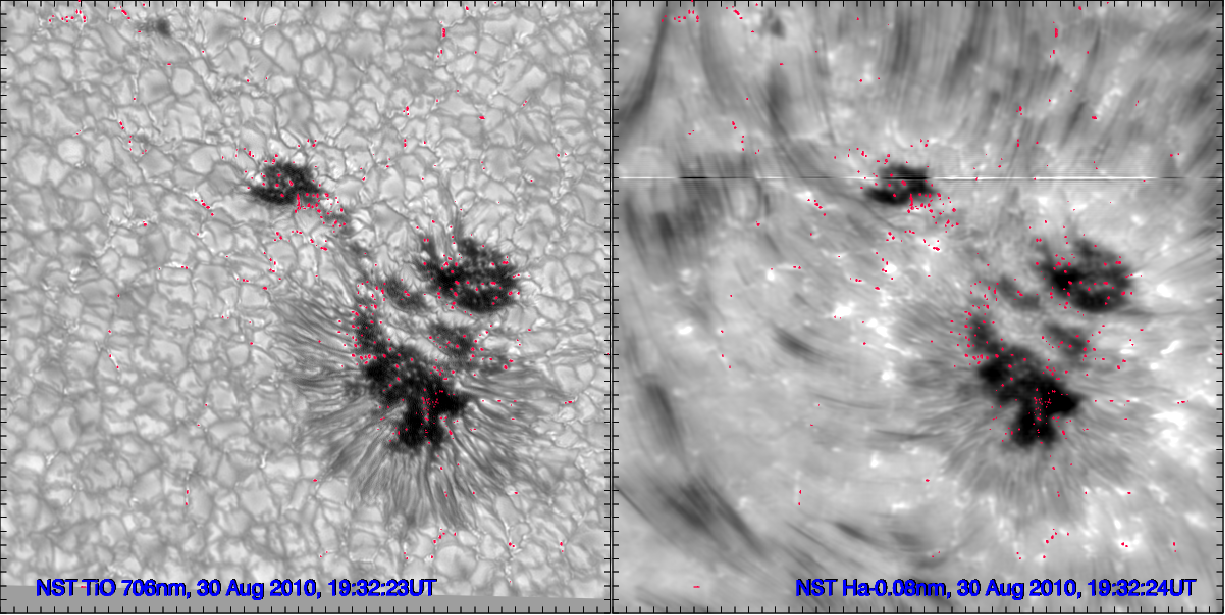 AR 1102 as seen through the TiO 706nm (left)
and the off-bad Halpha (right) filters. Images were taken on Aug 30, 2010.
The red contours in both images mark locations of the most intense bright points
as measured from the TiO image. The data shows excellent correspondence
between photospheric and Ha bright points, the latter being somewhat larger in size
(Posted: 3 Sept, 2010)
AR 1102 as seen through the TiO 706nm (left)
and the off-bad Halpha (right) filters. Images were taken on Aug 30, 2010.
The red contours in both images mark locations of the most intense bright points
as measured from the TiO image. The data shows excellent correspondence
between photospheric and Ha bright points, the latter being somewhat larger in size
(Posted: 3 Sept, 2010) |
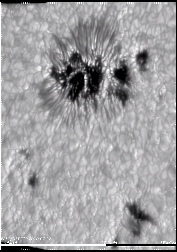 Movie of AR 11089 observed on 22 July 2010.
Movie of AR 11089 observed on 22 July 2010.
 (Posted: Sept: 3, 2010) (Posted: Sept: 3, 2010)
|
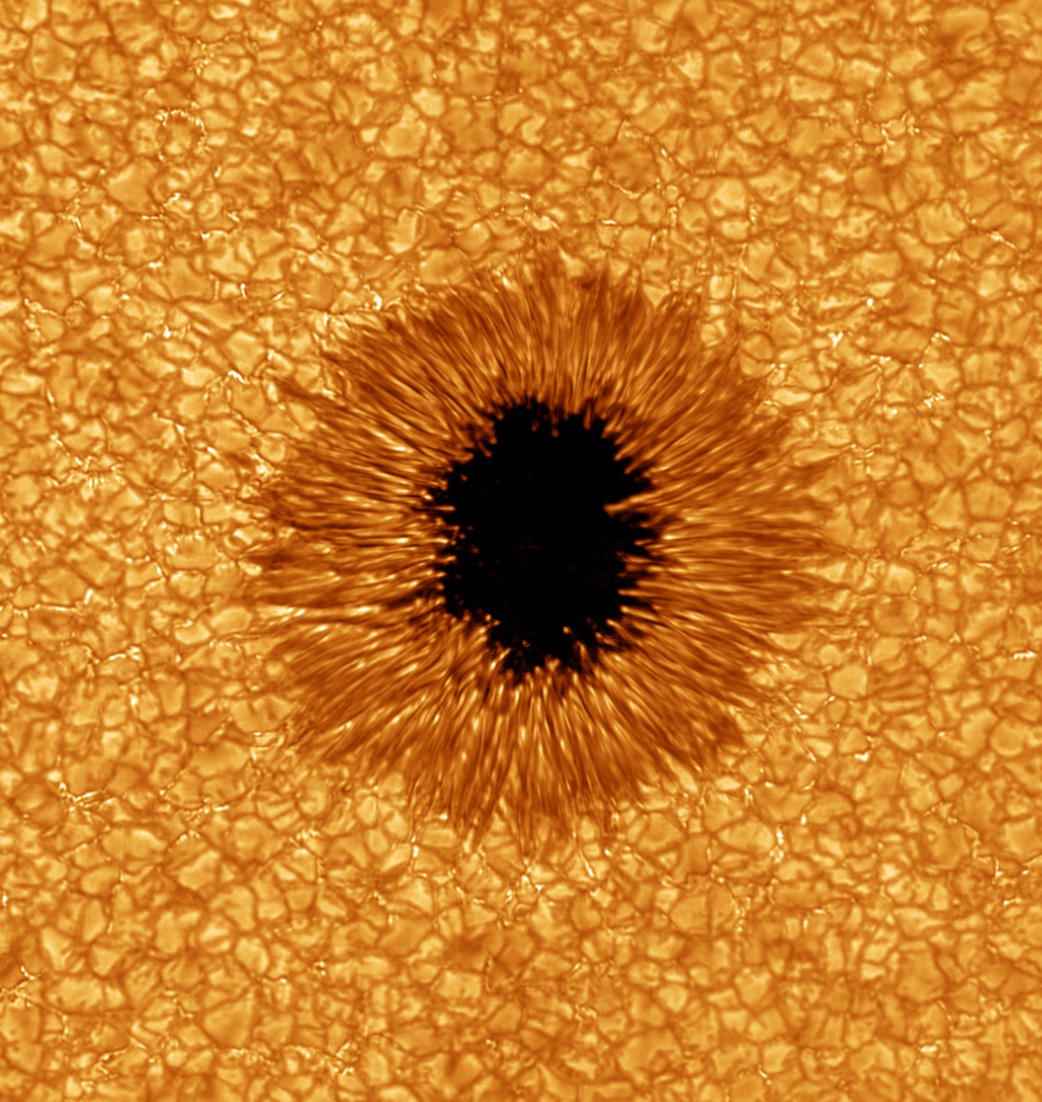 Image of AR NOAA 1084 taken on July 2, 2010 in TiO (706 nm) filter and with realtime correction for atmospheric distortion (adaptive optics). For perspective, the Earth is slightly smaller than the whole sunspot including the dark umbra and the daisy petal-like penumbra. The spot is surrounded by the Sun's ubiquitous granular field in which the small individual bright points in intergranular lanes are near the diffraction
limit of the telescope.
This image has been called
the most precise image of the Sun's surface ever taken and was chosen by the
editors of National Geographic as one of
the top ten space images of 2010
.
(Posted: 1 Sept, 2010)
Image of AR NOAA 1084 taken on July 2, 2010 in TiO (706 nm) filter and with realtime correction for atmospheric distortion (adaptive optics). For perspective, the Earth is slightly smaller than the whole sunspot including the dark umbra and the daisy petal-like penumbra. The spot is surrounded by the Sun's ubiquitous granular field in which the small individual bright points in intergranular lanes are near the diffraction
limit of the telescope.
This image has been called
the most precise image of the Sun's surface ever taken and was chosen by the
editors of National Geographic as one of
the top ten space images of 2010
.
(Posted: 1 Sept, 2010)
|
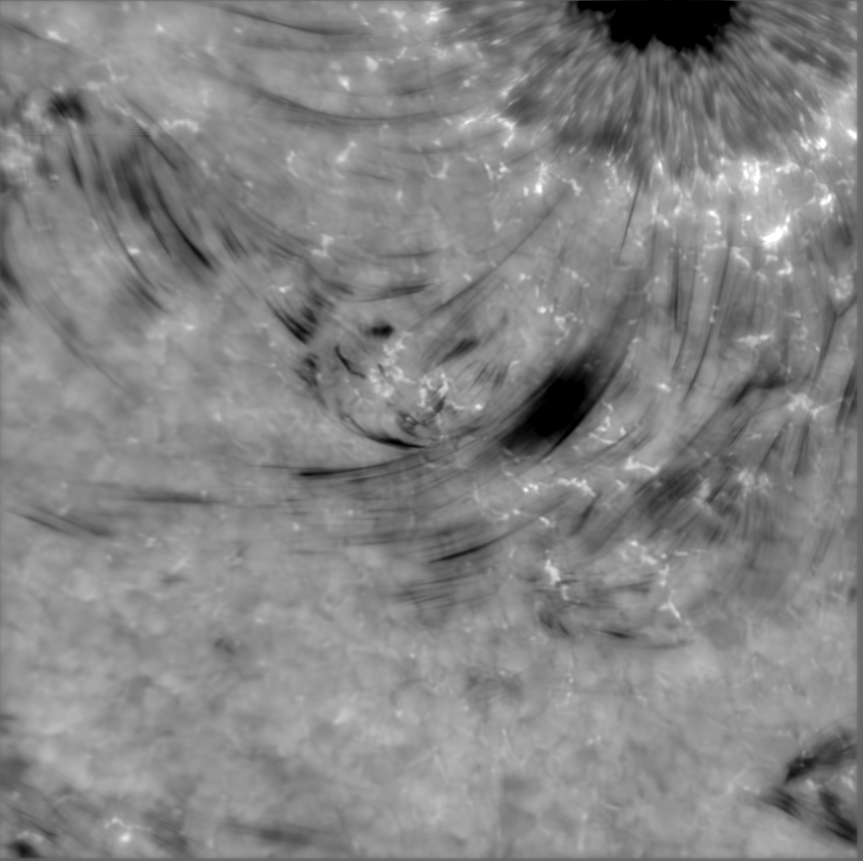 Halpha off-band image of the same active region taken a
day earlier reveals dynamics in the chromospheric layer overlying the surface
region shown in the full sunspot image. One can see ~50km/s "jets" arising
from the bright magnetic areas immediately outside the main body of the penumbra.
(Posted: 1 Sept, 2010)
Halpha off-band image of the same active region taken a
day earlier reveals dynamics in the chromospheric layer overlying the surface
region shown in the full sunspot image. One can see ~50km/s "jets" arising
from the bright magnetic areas immediately outside the main body of the penumbra.
(Posted: 1 Sept, 2010) |
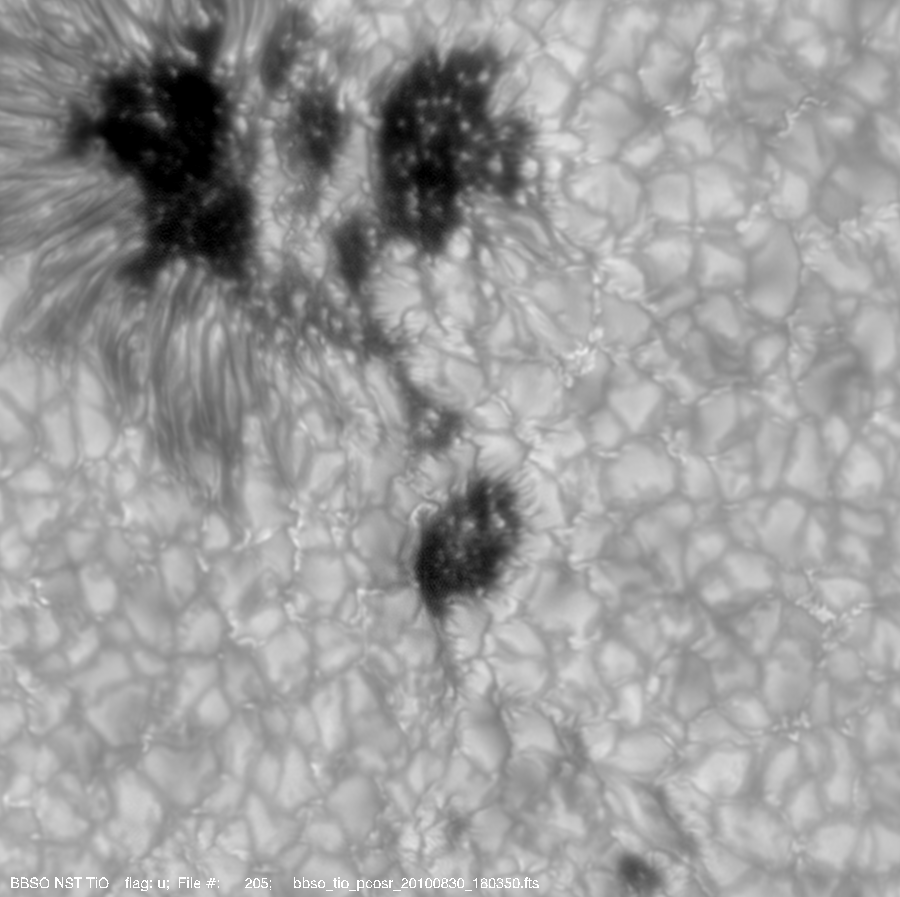 TiO 706nm image of AR 1102 taken on
Aug 30, 2010. The image shows several pores and a small sunspot partially
surrounded by a penumbra. (Posted: 1 Sept, 2010)
TiO 706nm image of AR 1102 taken on
Aug 30, 2010. The image shows several pores and a small sunspot partially
surrounded by a penumbra. (Posted: 1 Sept, 2010)
|



























